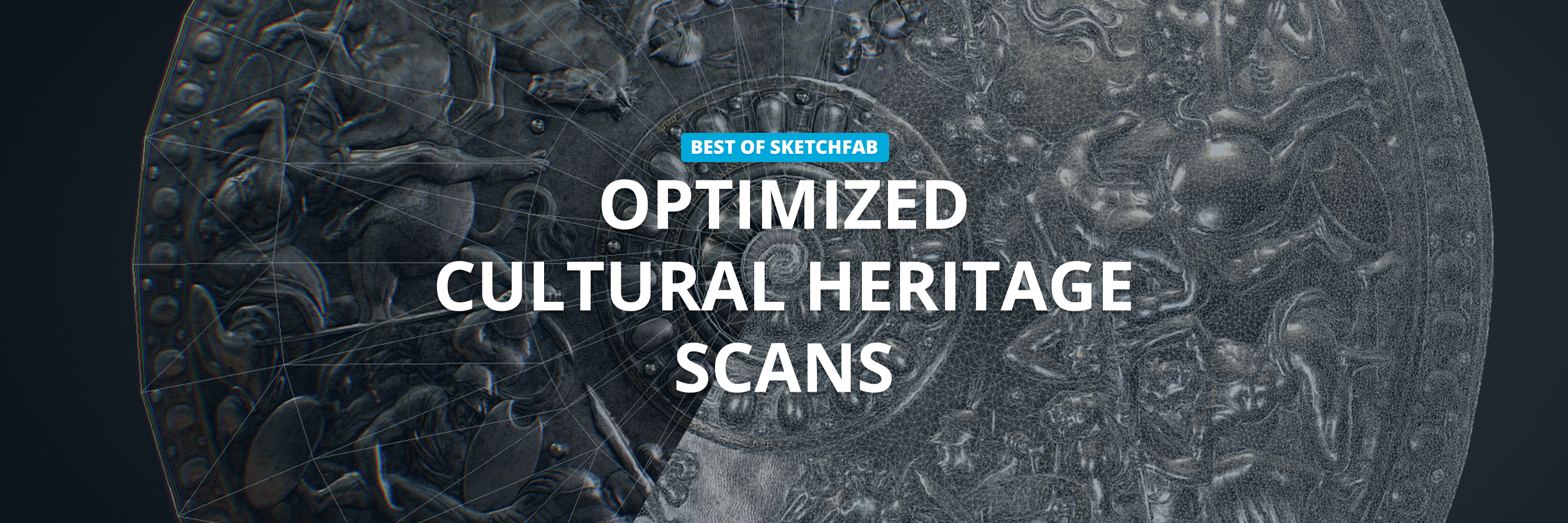Hello! Tom here, Cultural Heritage Lead at Sketchfab and one of the Community Team. Among many other things, I help advise on, advocate for, and promote publishing cultural heritage online in 3D.
In this Best of Sketchfab, I will focus on ‘optimized cultural heritage 3D’. While it is often desirable to publish high-resolution data within the field of GLAM digitization (GLAM = Galleries, Libraries, Archives & Museums), in certain cases there are plenty of arguments for publishing highly optimized versions of a 3D data set. A few benefits of optimized 3D models:
- Faster download times for people viewing your models
- Smoother performance on older or less powerful devices
- Models are AR & VR ready
- Your 3D data uses less energy for storage + display ?
Please enjoy some of my favorite optimized models, in no particular order.
Medieval Shield by Denis Cliofas
I love this optimized version of The Parade Shield of King Erik XIV of Sweden by /denis_cliofas. The original model published by /TheRoyalArmoury is 1 million triangles—this version is only 4.3 thousand ? To quote a comment from /denis_cliofas, “It all worked because of such a great scan that was used as the base.” Bonus point: it’s also downloadable under a Creative Commons Attribution license. Way to pay it forward, /denis_cliofas. ?
Terracotta Kylix (Courtesy of the Met) by Angel Cormier
Optimized cultural heritage 3D does not always begin life as a 3D file. In fact, there are quite a few people on Sketchfab publishing one of my favorite types of historical 3D: a 3D model based on existing 2D images. One recent example that caught my eye is Terracotta Kylix (Courtesy of The Met) by /angelcormier, who combined 5 public domain images available from the Metropolitan Museum of Art in New York to texture her model.
Glimmingehus medieval castle by VirtualSweden
Sketchfab member /virtualsweden has many excellent uploads on their profile, but their Glimmingehus medieval castle post is very clever and a nice example of how much you can show with an optimized 3D model. The complete model combines several optimized versions of photogrammetry scans of individual rooms of the medieval castle in a ‘dolls house’ style view, with detailed annotations taking you on a tour from the cellar to the upper loft.
Coffin stone by SenYul
What’s better than an optimized 3D mesh? An ULTRA OPTIMISED 3D MESH. Sketchfab member /senyul shows us all just what can be done with their model Coffin stone, for which they converted a 50 million face input mesh to just 56 triangles! Combined with the image texture and normal map, the effect is more convincing than you might expect.
Orbiter Space Shuttle OV-103 Discovery by The Smithsonian Institution
Did you know that the Smithsonian Institution runs a highly developed 3D digitization program? One of my favorite things about this project is that it has prioritized the production of ‘web-ready’ derivatives of the stunning high-resolution 3D scans that it is producing. You can explore the Smithsonian Institution’s growing library right here on Sketchfab. One of my favorite models posted by the Institution is (proud space geek here!) the Orbiter Space Shuttle OV-103 Discovery—many gigabytes of data parsed down to an easily digestible 150k faces!
Bonus! You can stream the high-resolution data set for the Orbiter Space Shuttle OV-103 in Sketchfab’s beta viewer for massive data:
Stream unlimited resolution #3D models right inside your browser, even on mobile!
Explore every detail of the Orbiter Space Shuttle OV-103 Discovery from @3D_Digi_SI @airandspace with Sketchfab's massive model support ?????
Try it yourself?https://t.co/bbWgZ6KaiL pic.twitter.com/ikqx6GClQK
— Sketchfab (@Sketchfab) March 2, 2020
I hope you enjoyed this list. What are your favorite optimized cultural heritage 3D models?


